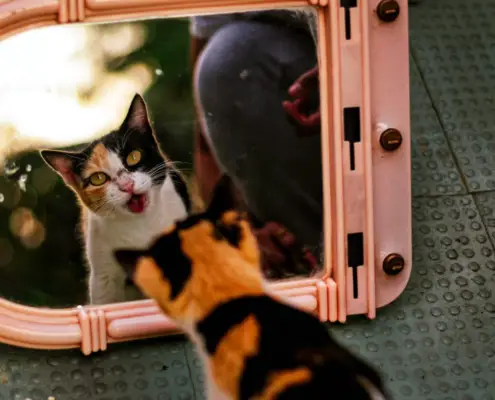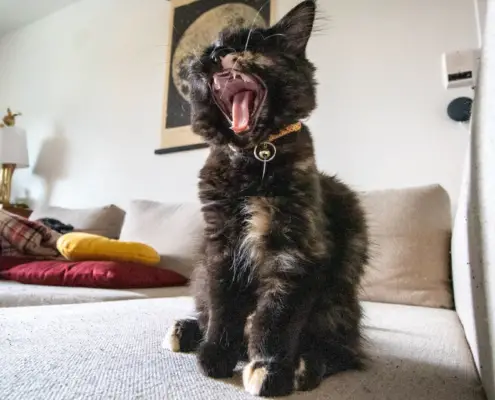
Cats have always captivated the human imagination with their grace, agility, and speed. From their sleek bodies to their nimble movements, they are truly remarkable creatures. But have you ever wondered just how fast cats can really run? In this article, we will delve into the fascinating world of feline speed and explore the factors that contribute to their incredible swiftness.
The Anatomy of a Fast Cat
To understand why cats are such speedy creatures, it is important to first examine their anatomy. Cats have a lean and muscular body structure, which allows for efficient movement. Their long and flexible spine, combined with powerful hind limbs, provides them with the ability to stretch and contract their muscles, propelling them forward with remarkable force. Additionally, their retractable claws and padded paws offer excellent traction, enabling them to maintain control and balance even at high speeds.
Average Running Speed of Cats
On average, domestic cats can reach speeds of around 30 miles per hour (48 kilometers per hour). This impressive velocity is comparable to the speed of a car driving through a residential area. However, it is important to note that not all cats have the same level of athleticism, and individual abilities may vary. Factors such as breed, age, and overall health can influence a cat’s running speed. Additionally, outdoor cats often have more opportunities for physical exercise, which can contribute to their overall fitness and agility.
Fastest Recorded Speeds of Domestic Cats
While the average running speed of cats is already impressive, some feline athletes have been known to reach even greater velocities. In fact, according to the Guinness World Records, the fastest recorded speed of a domestic cat is 55.5 miles per hour (89.2 kilometers per hour). This record was achieved by a tabby cat named Smokey in 2012. Smokey’s exceptional speed showcases the immense potential of cats when it comes to running.
Factors That Affect a Cat’s Speed
Various factors can influence a cat’s speed and overall agility. One crucial element is the cat’s physical condition. Just like humans, cats require regular exercise to maintain their fitness levels. A sedentary lifestyle can lead to muscle weakness and decreased speed. Furthermore, a cat’s age can impact its speed, as younger cats tend to be more energetic and agile than older ones. Lastly, the surface on which a cat is running can also affect its speed. Cats are known for their ability to sprint and change direction quickly, but on slippery or uneven surfaces, their speed may be compromised.
Comparing Cat Speeds to Other Animals
While cats are undoubtedly swift creatures, how do they measure up against other animals in terms of speed? When it comes to land animals, cats are among the fastest. They can outrun most domestic dogs and are comparable in speed to small deer and rabbits. However, they are no match for the extraordinary speeds of animals such as cheetahs, who can reach an astonishing 70 miles per hour (113 kilometers per hour). Nevertheless, cats’ ability to quickly accelerate and change direction sets them apart from many other animals.
The Need for Speed: Why Cats Run So Fast
Cats’ incredible speed is deeply rooted in their evolutionary history. In the wild, cats are both predators and prey, and their survival depends on their ability to quickly chase down prey or escape from potential predators. This need for speed has been honed over generations, resulting in the highly efficient and agile creatures we know today. Even domestic cats, who may not face the same life-or-death situations as their wild counterparts, still possess the same instincts and natural abilities that contribute to their impressive speed.
Fun Facts About Cat Speed
Here are a few fascinating facts about cat speed that might surprise you:
- Cats have a unique running style called “bounding,” where all four paws momentarily leave the ground during each stride. This technique allows for maximum acceleration and speed.
- Cats can make quick turns in mid-air while running, thanks to their exceptional balance and flexibility.
- The average stride length of a running cat is approximately 16 inches (40 centimeters), which helps them cover more ground with each step.
- Cats have an extraordinary ability to judge distance accurately, which aids them in calculating the speed and trajectory required to catch their prey.
Tips for Keeping Your Cat Active and Fit
To ensure that your feline companion remains healthy and agile, it is crucial to provide them with opportunities for exercise. Here are some tips to keep your cat active and fit:
- Play with your cat regularly using toys that encourage running and jumping.
- Create an enriching environment with climbing structures and scratching posts to encourage physical activity.
- Provide interactive feeding toys that require your cat to work for their food, promoting mental stimulation and physical exercise.
- Consider setting up a safe and secure outdoor enclosure where your cat can explore and engage in natural behaviors.
By incorporating these activities into your cat’s routine, you can help them maintain their speed and agility while improving their overall well-being.
Appreciating the Speed and Agility of Our Feline Friends
Cats are truly remarkable creatures when it comes to speed and agility. Their sleek bodies, powerful muscles, and remarkable reflexes allow them to reach impressive velocities. Whether they are sprinting across the room in pursuit of a toy or gracefully leaping through the air, cats never fail to captivate us with their incredible speed. By understanding the factors that contribute to their swiftness and providing them with opportunities for exercise, we can ensure that our feline friends remain healthy, active, and able to unleash their need for speed.
Unleash the need for speed in your feline companion! Keep your cat healthy and active with these tips. Try out interactive toys and provide an enriching environment to ensure your cat can reach their full potential. Witness the grace and agility of your cat as they run, jump, and play with unmatched speed.
If you enjoyed my article, I would appreciate you sharing it with your network.

Sima Ndlebe
Sima writes for CatBuzz. He is interested in Cats, Health and Fitness, and Entrepreneurship.
Published: 13 October 2023



